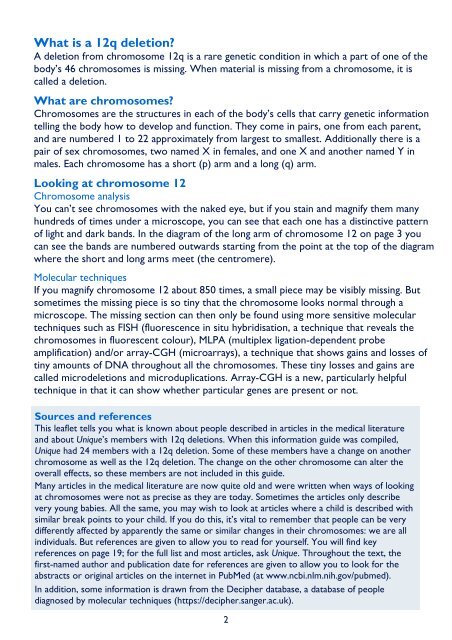12q deletion - Unique - The Rare Chromosome Disorder Support ...
12q deletion - Unique - The Rare Chromosome Disorder Support ...
12q deletion - Unique - The Rare Chromosome Disorder Support ...
Create successful ePaper yourself
Turn your PDF publications into a flip-book with our unique Google optimized e-Paper software.
What is a <strong>12q</strong> <strong>deletion</strong>?<br />
A <strong>deletion</strong> from chromosome <strong>12q</strong> is a rare genetic condition in which a part of one of the<br />
body’s 46 chromosomes is missing. When material is missing from a chromosome, it is<br />
called a <strong>deletion</strong>.<br />
What are chromosomes?<br />
<strong>Chromosome</strong>s are the structures in each of the body’s cells that carry genetic information<br />
telling the body how to develop and function. <strong>The</strong>y come in pairs, one from each parent,<br />
and are numbered 1 to 22 approximately from largest to smallest. Additionally there is a<br />
pair of sex chromosomes, two named X in females, and one X and another named Y in<br />
males. Each chromosome has a short (p) arm and a long (q) arm.<br />
Looking at chromosome 12<br />
<strong>Chromosome</strong> analysis<br />
You can’t see chromosomes with the naked eye, but if you stain and magnify them many<br />
hundreds of times under a microscope, you can see that each one has a distinctive pattern<br />
of light and dark bands. In the diagram of the long arm of chromosome 12 on page 3 you<br />
can see the bands are numbered outwards starting from the point at the top of the diagram<br />
where the short and long arms meet (the centromere).<br />
Molecular techniques<br />
If you magnify chromosome 12 about 850 times, a small piece may be visibly missing. But<br />
sometimes the missing piece is so tiny that the chromosome looks normal through a<br />
microscope. <strong>The</strong> missing section can then only be found using more sensitive molecular<br />
techniques such as FISH (fluorescence in situ hybridisation, a technique that reveals the<br />
chromosomes in fluorescent colour), MLPA (multiplex ligation-dependent probe<br />
amplification) and/or array-CGH (microarrays), a technique that shows gains and losses of<br />
tiny amounts of DNA throughout all the chromosomes. <strong>The</strong>se tiny losses and gains are<br />
called micro<strong>deletion</strong>s and microduplications. Array-CGH is a new, particularly helpful<br />
technique in that it can show whether particular genes are present or not.<br />
Sources and references<br />
This leaflet tells you what is known about people described in articles in the medical literature<br />
and about <strong>Unique</strong>’s members with <strong>12q</strong> <strong>deletion</strong>s. When this information guide was compiled,<br />
<strong>Unique</strong> had 24 members with a <strong>12q</strong> <strong>deletion</strong>. Some of these members have a change on another<br />
chromosome as well as the <strong>12q</strong> <strong>deletion</strong>. <strong>The</strong> change on the other chromosome can alter the<br />
overall effects, so these members are not included in this guide.<br />
Many articles in the medical literature are now quite old and were written when ways of looking<br />
at chromosomes were not as precise as they are today. Sometimes the articles only describe<br />
very young babies. All the same, you may wish to look at articles where a child is described with<br />
similar break points to your child. If you do this, it’s vital to remember that people can be very<br />
differently affected by apparently the same or similar changes in their chromosomes: we are all<br />
individuals. But references are given to allow you to read for yourself. You will find key<br />
references on page 19; for the full list and most articles, ask <strong>Unique</strong>. Throughout the text, the<br />
first-named author and publication date for references are given to allow you to look for the<br />
abstracts or original articles on the internet in PubMed (at www.ncbi.nlm.nih.gov/pubmed).<br />
In addition, some information is drawn from the Decipher database, a database of people<br />
diagnosed by molecular techniques (https://decipher.sanger.ac.uk).<br />
2
















